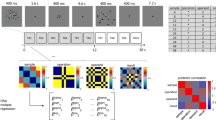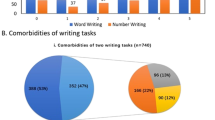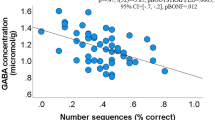Abstract
In our daily lives, we are constantly exposed to numbers and letters. However, it is still under debate how letters and numbers are processed in the brain, while information on this topic would allow for a more comprehensive understanding of, for example, known influences of language on numerical cognition or neural circuits shared by numerical cognition and language processing. Some findings provide evidence for a double dissociation between numbers and letters, with numbers being represented in the right and letters in the left hemisphere, while the opposing view suggests a shared neural network. Since processing may depend on the task, we address the reported inconsistencies in a very basic symbol copying task using functional near-infrared spectroscopy (fNIRS). fNIRS data revealed that both number and letter copying rely on the bilateral middle and left inferior frontal gyri. Only numbers elicited additional activation in the bilateral parietal cortex and in the left superior temporal gyrus. However, no cortical activation difference was observed between copying numbers and letters, and there was Bayesian evidence for common activation in the middle frontal gyri and superior parietal lobules. Therefore, we conclude that basic number and letter processing are based on a largely shared cortical network, at least in a simple task such as copying symbols. This suggests that copying can be used as a control condition for more complex tasks in neuroimaging studies without subtracting stimuli-specific activation.



Similar content being viewed by others
Notes
Additionally, ANCOVAs were conducted to contrast copying numbers and letters by adding the difference in RT as a covariate. The contrast was not significant for any channel (p < 0.05, BH corrected). Therefore, the non-significant results are not due to the different RTs in copying numbers and letters.
References
Abboud S, Maidenbaum S, Dehaene S, Amedi A (2015) A number-form area in the blind. Nat Commun 6:6026. https://doi.org/10.1038/ncomms7026
Acheson DJ, Hagoort P (2013) Stimulating the brain’s language network: syntactic ambiguity resolution after TMS to the inferior frontal gyrus and middle temporal gyrus. J Cogn Neurosci 25(10):1664–1677. https://doi.org/10.1162/jocn_a_00430
Amalric M, Dehaene S (2016) Origins of the brain networks for advanced mathematics in expert mathematicians. Proc Natl Acad Sci 113(18):4909–4917. https://doi.org/10.1073/pnas.1603205113
Ansari D (2008) Effects of development and enculturation on number representation in the brain. Nat Rev Neurosci 9(4):278–291. https://doi.org/10.1038/nrn2334
Ansari D (2016) The neural roots of mathematical expertise. Proc Natl Acad Sci 113(18):4887–4889. https://doi.org/10.1073/pnas.1604758113
Arsalidou M, Taylor MJ (2011) Is 2 + 2 = 4? Meta-analyses of brain areas needed for numbers and calculations. NeuroImage 54(3):2382–2393. https://doi.org/10.1016/j.neuroimage.2010.10.009
Baldo JV, Dronkers NF (2007) Neural correlates of arithmetics and language comprehension: a common substrate? Neuropsychologia 45:229–235. https://doi.org/10.1016/j.neuropsychologia.2006.07.014
Carreiras M, Quiñones I, Hernández-Cabrera JA, Duñabeitia JA (2015) Orthographic coding: brain activation for letters, symbols, and digits. Cereb Cortex 25(12):4748–4760. https://doi.org/10.1093/cercor/bhu163
Chan AM, Dykstra AR, Jayaram V, Leonard MK, Travis KE, Gygi B, Baker JM, Eskandar E, Hochberg LE, Halgren E, Cash SS (2014) Speech-specific tuning of neurons in human superior temporal gyrus. Cereb Cortex 24(10):2679–2693. https://doi.org/10.1093/cercor/bht127
Cipolotti L, Butterworth B (1995) Toward a multiroute model of number processing: impaired number transcoding with preserved calculation skills. J Exp Psychol Gen 124(4):375. https://doi.org/10.1037/0096-3445.124.4.375
Cohen L, Dehaene S, Naccache L, Lehéricy S, Dehaene-Lambertz G, Hénaff MA, Michel F (2000) The visual word form area: spatial and temporal characterization of an initial stage of reading in normal subjects and posterior split-brain patients. Brain 123(2):291–307. https://doi.org/10.1093/brain/123.2.291
Corbetta M, Shulman GL (2002) Control of goal-directed and stimulus-driven attention in the brain. Nat Rev Neurosci 3(3):215–229. https://doi.org/10.1038/nrn755
Cui X, Bray S, Reiss AL (2010) Functional near infrared spectroscopy (NIRS) signal improvement based on negative correlation between oxygenated and deoxygenated hemoglobin dynamics. NeuroImage 49(4):3039–3046. https://doi.org/10.1016/j.neuroimage.2009.11.050
Dehaene S (2011) The number sense: how the mind creates mathematics, 2nd edn. Oxford University Press, Oxford. https://doi.org/10.2307/2589308
Dehaene S, Akhavein R (1995) Attention, automaticity, and levels of representation in number processing. J Exp Psychol Learn Mem Cogn 21(2):314–326. https://doi.org/10.1037/0278-7393.21.2.314
Dehaene S, Cohen L (1995) Towards an anatomical and functional model of number processing. Math Cogn 1(1):83–120
Dehaene S, Dehaene-Lambertz G (2016) Is the brain prewired for letters? Nat Neurosci 19(9):1192–1193. https://doi.org/10.1038/nn.4369
Dehaene S, Piazza M, Pinel P, Cohen L (2003) Three parietal circuits for number processing. Cogn Neuropsychol 20(3–6):487–506. https://doi.org/10.1080/02643290244000239
Ester EF, Sprague TC, Serences JT (2015) Parietal and frontal cortex encode stimulus-specific mnemonic representations during visual working memory. Neuron 87(4):893–905. https://doi.org/10.1016/j.neuron.2015.07.013
Frankland SM, Greene JD (2015) An architecture for encoding sentence meaning in left mid-superior temporal cortex. Proc Natl Acad Sci 112(37):11732–11737. https://doi.org/10.1073/pnas.1421236112
Friederici AD (2011) The brain basis of language processing: from structure to function. Physiol Rev 91(4):1357–1392. https://doi.org/10.1152/physrev.00006.2011
Fulbright RK, Manson SC, Skudlarski P, Lacadie CM, Gore JC (2003) Quantity determination and the distance effect with letters, numbers, and shapes: a functional MR imaging study of number processing. Am J Neuroradiol 24(2):193–200
Grotheer M, Herrmann K-H, Kovacs G (2016) Neuroimaging evidence of a bilateral representation for visually presented numbers. J Neurosci 36(1):88–97. https://doi.org/10.1523/JNEUROSCI.2129-15.2016
Hampshire A, Chamberlain SR, Monti MM, Duncan J, Owen AM (2010) The role of the right inferior frontal gyrus: inhibition and attentional control. NeuroImage 50(3):1313–1319. https://doi.org/10.1016/j.neuroimage.2009.12.109
Hannagan T, Amedi A, Cohen L, Dehaene-Lambertz G, Dehaene S (2015) Origins of the specialization for letters and numbers in ventral occipitotemporal cortex. Trends Cogn Sci 19(7):374–382. https://doi.org/10.1016/j.tics.2015.05.006
Holm S (1979) A simple sequentially rejective multiple test procedure. Scand J Stat 6(2):65–70. https://doi.org/10.2307/4615733
James KH, Gauthier I (2006) Letter processing automatically recruits a sensory–motor brain network. Neuropsychologia 44(14):2937–2949. https://doi.org/10.1016/j.neuropsychologia.2006.06.026
Japee S, Holiday K, Satyshur MD, Mukai I, Ungerleider LG (2015) A role of right middle frontal gyrus in reorienting of attention: a case study. Front Syst Neurosci 9:23. https://doi.org/10.3389/fnsys.2015.00023
Joseph JE, Cerullo MA, Farley AB, Steinmetz NA, Mier CR (2006) fMRI correlates of cortical specialization and generalization for letter processing. NeuroImage 32(2):806–820. https://doi.org/10.1016/j.neuroimage.2006.04.175
Katzev M, Tuscher O, Hennig J, Weiller C, Kaller CP (2013) Revisiting the Functional specialization of left inferior frontal gyrus in phonological and semantic fluency: the crucial role of task demands and individual ability. J Neurosci 33(18):7837–7845. https://doi.org/10.1523/JNEUROSCI.3147-12.2013
Kaufmann L, Wood G, Rubinsten O, Henik A (2011) Meta-analyses of developmental fMRI studies investigating typical and atypical trajectories of number processing and calculation. Dev Neuropsychol 36(6):763–787. https://doi.org/10.1080/87565641.2010.549884
Klein E, Moeller K, Nuerk H-C, Willmes K (2010) On the neuro-cognitive foundations of basic auditory number processing: an fMRI study. Behav Brain Funct 6:42. https://doi.org/10.1186/1744-9081-6-42
Klein E, Willmes K, Jung S, Huber S, Braga LW, Moeller K (2016) Differing connectivity of Exner’s area for numbers and letters. Front Hum Neurosci 10:281. https://doi.org/10.3389/fnhum.2016.00281
Knops A, Nuerk H-C, Fimm B, Vohn R, Willmes K (2006) A special role for numbers in working memory? An fMRI study. Neuroimage 29(1):1–14. https://doi.org/10.1016/j.neuroimage.2005.07.009
Kruschke JK (2013) Bayesian estimation supersedes the t test. J Exp Psychol 142(2):573–588. https://doi.org/10.1037/a0029177
Liu C-L, Hue C-W, Chen C-C, Chuang K-H, Liang K-C, Wang Y-H, Wu CW, Chen J-H (2006) Dissociated roles of the middle frontal gyri in the processing of Chinese characters. Neuroreport 17(13):1397–1401. https://doi.org/10.1097/01.wnr.0000233090.00463.35
McCloskey M, Schubert T (2014) Shared versus separate processes for letter and digit identification. Cogn Neuropsychol 31(5–6):437–460. https://doi.org/10.1080/02643294.2013.869202
Menon V, Rivera SM, White CD, Glover GH, Reiss AL (2000) Dissociating prefrontal and parietal cortex activation during arithmetic processing. Neuroimage 12(4):357–365. https://doi.org/10.1006/nimg.2000.0613
Park J, Hebrank A, Polk TA, Park DC (2012) Neural disocciation of number and letter recognition and its relationship to parietal numerical processing. J Cogn Neurosci 24(1):39–50. https://doi.org/10.1162/jocn_a_00085
Pernet C, Celsis P, Démonet J-F (2005) Selective response to letter categorization within the left fusiform gyrus. NeuroImage 28(3):738–744. https://doi.org/10.1016/j.neuroimage.2005.06.046
Polk TA, Stallcup M, Aguirre GK, Alsop DC, D’esposito M, Detre JA, Farah MJ (2002) Neural specialization for letter recognition. J Cogn Neurosci 14(2):145–159. https://doi.org/10.1162/089892902317236803
Reilhac C, Peyrin C, Démonet J-F, Valdois S (2013) Role of the superior parietal lobules in letter-identity processing within strings: FMRI evidence from skilled and dyslexic readers. Neuropsychologia 51(4):601–612. https://doi.org/10.1016/j.neuropsychologia.2012.12.010
Rivera SM, Reiss AL, Eckert MA, Menon V (2005) Developmental changes in mental arithmetic: evidence for increased functional specialization in the left inferior parietal cortex. Cereb Cortex 15(11):1779–1790. https://doi.org/10.1093/cercor/bhi055
Rorden C, Brett M (2000) Stereotaxic display of brain lesions. Behav Neurol 12(4):191–200. https://doi.org/10.1155/2000/421719
Roux FE, Lubrano V, Lauwers-Cances V, Giussani C, Démonet JF (2008) Cortical areas involved in Arabic number reading. Neurology 70(3):210–217. https://doi.org/10.1212/01.wnl.0000297194.14452.a0
Sasai S, Homae F, Watanabe H, Taga G (2011) Frequency-specific functional connectivity in the brain during resting state revealed by NIRS. NeuroImage 56(1):252–257. https://doi.org/10.1016/j.neuroimage.2010.12.075
Shum J, Hermes D, Foster BL, Dastjerdi M, Rangarajan V, Winawer J, Miller KJ, Parvizi J (2013) A brain area for visual numerals. J Neurosci 33(16):6709–6715. https://doi.org/10.1523/JNEUROSCI.4558-12.2013
Singh AK, Okamoto M, Dan H, Jurcak V, Dan I (2005) Spatial registration of multichannel multi-subject fNIRS data to MNI space without MRI. NeuroImage 27(4):842–851. https://doi.org/10.1016/j.neuroimage.2005.05.019
Sokolowski HM, Fias W, Ononye BC, Ansari D (2017) Are numbers grounded in a general magnitude processing system? A functional neuroimaging meta-analysis. Neuropsychologia 105:50–69. https://doi.org/10.1016/j.neuropsychologia.2017.01.019
Soltanlou M, Artemenko C, Ehlis A-C, Huber S, Fallgatter AJ, Dresler T, Nuerk H-C (2018) Reduction but not shift in brain activation in arithmetic learning in children: a simultaneous fNIRS-EEG study. Sci Rep 8:1707. https://doi.org/10.1038/s41598-018-20007-x
Starrfelt R, Behrmann M (2011) Number reading in pure alexia—A review. Neuropsychologia 49(9):2283–2298. https://doi.org/10.1016/j.neuropsychologia.2011.04.028
Tong Y, Frederick B (2010) Time lag dependent multimodal processing of concurrent fMRI and near-infrared spectroscopy (NIRS) data suggests a global circulatory origin for low-frequency oscillation signals in human brain. NeuroImage 53(2):553–564. https://doi.org/10.1016/j.neuroimage.2010.06.049
Tsuzuki D, Jurcak V, Singh AK, Okamoto M, Watanabe E, Dan I (2007) Virtual spatial registration of stand-alone fNIRS data to MNI space. NeuroImage 34(4):1506–1518. https://doi.org/10.1016/j.neuroimage.2006.10.043
Tzourio-Mazoyer N, Landeau B, Papathanassiou D, Crivello F, Etard O, Delcroix N, Mazoyer B, Joliot M (2002) Automated anatomical labeling of activations in SPM using a macroscopic anatomical parcellation of the MNI MRI single-subject brain. NeuroImage 15(1):273–289. https://doi.org/10.1006/nimg.2001.0978
Venkatraman V, Ansari D, Chee MW (2005) Neural correlates of symbolic and non-symbolic arithmetic. Neuropsychologia 43(5):744–753. https://doi.org/10.1016/j.neuropsychologia.2004.08.005
Yeo DJ, Wilkey ED, Price GR (2017) The search for the number form area: a functional neuroimaging meta-analysis. Neurosci Biobehav Rev 78:145–160. https://doi.org/10.1016/j.neubiorev.2017.04.027
Zhou X, Chen C, Zhang H, Xue G, Dong Q, Jin Z, Zhang L, Peng C, Zhao H, Guo Y, Jiang T, Chen C (2006) Neural substrates for forward and backward recitation of numbers and the alphabet: a close examination of the role of intraparietal sulcus and perisylvian areas. Brain Res 1099(1):109–120. https://doi.org/10.1016/j.brainres.2006.01.133
Acknowledgements
This research was supported by the LEAD Graduate School & Research Network (GSC1028), which is funded within the framework of the Excellence Initiative of the German federal and state governments. This research was further funded by a Grant from the Science Campus Tübingen, project 8.4 to HCN supporting MS. MS was also supported by the DFG Grant (NU 265/3-1) to HCN. ACE was partly supported by the IZKF Tübingen (Junior Research Group, Grant 2115-0-0). We would like to thank Minako Uga and Ippeita Dan for their help in preparing the spatial registration and anatomical labeling of fNIRS channels. We would also like to thank our research assistants for their help in data collection and language proofreading of the manuscript.
Author information
Authors and Affiliations
Corresponding author
Rights and permissions
About this article
Cite this article
Artemenko, C., Coldea, A., Soltanlou, M. et al. The neural circuits of number and letter copying: an fNIRS study. Exp Brain Res 236, 1129–1138 (2018). https://doi.org/10.1007/s00221-018-5204-8
Received:
Accepted:
Published:
Issue Date:
DOI: https://doi.org/10.1007/s00221-018-5204-8




